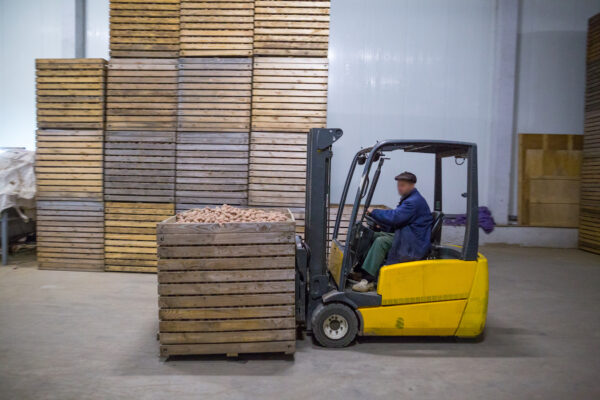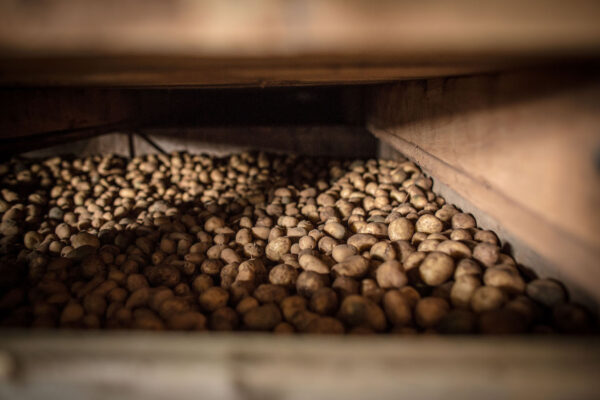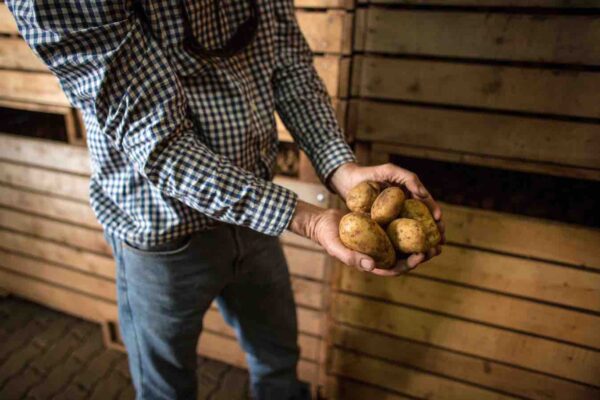Efficient Potato Cold Storage: Solutions for Long-Term Preservation
Successful long-term storage of potatoes is often challenging. The tubers are likely to suffer challenges like sprouting, shrinking, and rotting, for which storage can be difficult. For this reason, solutions such as cold storage are intended to keep them fresh and avoid spoiling, all while complying with export standards on safety, quality, and shelf-life.
Across Africa, potatoes are one of the most produced and consumed crops, yet, the industry feels the weight of difficult production conditions, especially post-harvest management. Cold storage is an essential part of potato supply chains, with its main objectives being to maintain the quality and prolong the shelf life and retain their nutritional value. By providing a regulated environment that manages temperature, humidity, and other factors, cold storage facilities offer a regulated environment to achieve this. However, running an inefficient potato cold storage facility may be difficult and expensive due to the reasons below.
Challenges in Potato Storage: Product Loss and High Energy Costs
- Risk of product loss: improper temperature and humidity control can cause potatoes to spoil, shrink or develop sprouts, reducing their quality and shelf-life. Product loss can be cut down by proper storage protocols and monitoring crop conditions regularly. The most common diseases causing problems in storage are bacterial soft rot (blackleg, Dickeya) late blight, pink rot and leak, which are caused by improper storage such as high humidity.
- High energy costs: Potato cold storage requires significant energy to maintain the desired temperature and humidity levels. According to Potato Processing International, energy costs can account for up to 50% of the total operating costs of a cold storage facility. Furthermore, the increase in energy costs is also of great concern, as many are reluctant to store the crop, particularly while the prices are high.
Benefits and Applications of Long-Term Storage Solutions for Agricultural Products
Among the many solutions designed to cater to the above challenges, are long-term storage solutions. This is the optimal solution for bulky crops such as potatoes and onions, or for fruits that can store for many months (apples and oranges.) Other crops that benefit from long-term storage include potatoes seed, shallots, carrots, sweet potatoes, pumpkins, garlic, ginger, seeds and grains.
For agribusiness and traders of these products, storing them for extended periods offers a competitive advantage. It enables them to meet the demands of distant markets, accommodate fluctuating supply and demand cycles, and optimise logistical operations. Additionally, for processing companies of value-added products such as potato crisps and French fries, long-term storage solutions allow room for uniformity in their supply, stable quantity and good quality. On a smaller scale, efficient long-term storage solutions can help farmers time the market or save their seed from season to season. On a larger scale, it enables communities of smallholder farmers to pool their harvests to time the market or sell to processors.
Factors for Efficient Potato Cold Storage and Long-Term Preservation
Modern storage of potatoes is complicated and requires space and a certain know-how that not all growers have. Cold storage technology varies in practice but consists of the same basics of a cold environment achieved either through mechanical refrigeration that can store potatoes at around 4°C for up to eight months, or via ambient cooling using somewhat less efficient straw bales for insulation. Where finances are limited, ambient cooling is more affordable and can keep potatoes fresh for 1-3 months following harvest.
1. Temperature
Several factors can influence temperature management for stored potatoes. These include whether the potatoes are to be marketed for processing, as fresh table stock, or as seed. For example, crisps (chips) are stored between +7 and +10° C, chips (fries) between +5 and +6° C, and seed potatoes between +4 and +5° C. It is important to differentiate between storage for table potatoes and seed potato storage, as the main objective of table potato storage is to obtain the maximum quantity of tubers of desired quality for the consumers. While in seed potatoes, the goal is to have optimum development of sprouts before planting. In both cases, the farmer requires the maximum return from his investment in time, materials, equipment and buildings.
Other factors affecting the temperature management for stored potatoes include the temperature of the tubers at the time they are placed in storage; the length of time the tubers are to be stored; the extent of tuber damage at harvest; and the presence of disease organisms.
2. Humidity
The first step to long-term storage of potatoes is to dry them at +25° C and relative humidity between 85% to 95%. The storage temperature and humidity affect the curing process, a necessary step for potatoes to self-cure any bruises and cuts gotten during harvesting, pre-storage handling, and transport. In extreme situations, the air needs to be humidified during the drying process to ensure optimum wound healing during this period. It is also necessary, during the entire storage period, to minimise tuber weight loss, which rapidly increases at relative humidity levels below 90%.
3. Ventilation and air movement
Ventilation is the most important factor for maintaining the correct temperature, relative humidity, and air quality within the cold store. The primary function of air movement is to maintain a uniform temperature and humidity and prevent warm spots. As it stands, potatoes have a relatively high moisture content, and excessive moisture from condensation can lead to the growth of bacteria, fungi, and molds, which can cause spoilage and affect the flavour and texture of the potatoes. Additionally, adequate ventilation allows controlled humidity levels by allowing excess moisture to escape, preventing condensation on the surface of the potatoes. In turn, this helps to maintain the potatoes’ quality and reduce the risk of rotting.
Furthermore, the tubers naturally release carbon dioxide as part of their metabolic process. And if the gas accumulates in the storage area, it can lead to the development of off-flavours and promote the growth of pathogens. For these reasons, proper ventilation ensures the removal of carbon dioxide, maintaining a healthier storage environment for the potatoes.
Proper airflow helps prevent the build-up of moisture and carbon dioxide, reducing the risk of disease development. Additionally, efficient grading ensures that only high-quality potatoes are stored, reducing the risk of disease transmission. Carefully inspecting and sorting them to remove any damaged, bruised, or diseased tubers would prevent the quick spread of diseases to healthy ones.
4. Respiration and Sprouting
The potato tuber reacts like any living organism; respiration increases with increasing temperatures. When the respiration increases so does the tuber weight loss. Since lower temperatures also maintain dormancy, it is important to ensure that temperatures are maintained as low as possible without otherwise decreasing quality.
It is important to keep potatoes in complete darkness during storage, since exposure to light, even for brief periods, can trigger sprouting. For long storage periods of 3 to 5 months, depending on the variety, a sprout inhibitor is suitable for potatoes other than those for seed. Therefore, it is important to store potatoes separately from ethylene-producing fruits and vegetables to reduce exposure.
5. Energy-efficiency
The main way of reducing the energy consumption of cold storage is to invest in proper energy-efficient equipment, which includes compressors, evaporators and condensers designed and developed to consume less energy while offering good levels of performance. Additionally, ensuring energy-saving practices such as controlling door openings can help to reduce energy costs. It is also recommended that you adopt cold storage facilities that include remote monitoring systems that alert when changes in humidity and temperature levels occur, or when unusual energy peaks happen. This way, you can generate data that can help identify patterns in temperature and humidity levels, so agribusinesses can make informed decisions, such as building and respecting protocols.
The InspiraFarms Cooling Solution
Overall, a well-designed cold storage facility with meticulous attention to the above factors can extend the shelf life of potatoes, enhance their quality, and provide valuable benefits to agribusinesses, processors, and farmers. We offer modular and prefabricated storage structures, with special insulation, ventilation, and cooling systems for ensuring optimum temperature level and appropriate storage conditions, which ensures minimised mass loss and the reduction in product quality. With this solution, you will have access to:
- Special ventilation systems, according to the product storage type
- Air circulation with high-flow axial fans.
- Automatic air refreshment systems for tropical environments, replacing the more traditional hatches.
- Special humidification system for long-term storage.
- CO2, ethylene, temperature, and humidity level control system.
- Dedicated IoT-driven systems for modified atmosphere.
As well, InspiraFarms Cooling offers the best cooling performance through highly energy-efficient systems and real-time data remote monitoring. InspiraFarms Cooling offers a range of solutions tailored for each variety and market for fresh and processing products. Ask for a quote now.





